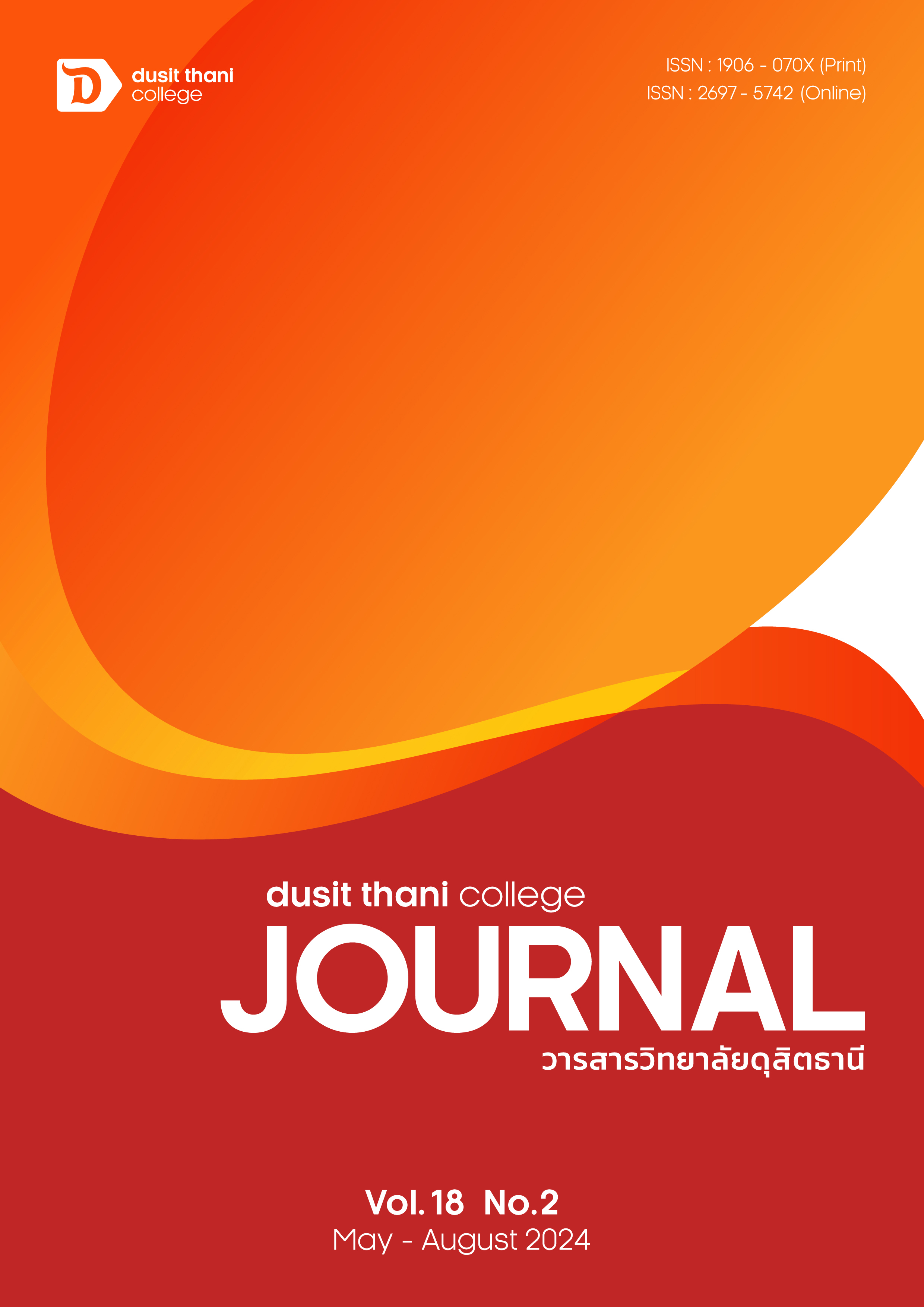Guidelines for Increasing the Effectiveness of Teaching and Learning Management Through Blended Learning Systems: A Case Study of Dusit Thani College
Main Article Content
Abstract
The objectives of this research are as follows: 1) Analyze the problems and obstacles in using blended learning systems, 2) Study the needs of both students and instructors, and find solutions to address the issues in using blended learning systems, and 3) Propose strategies to enhance the effectiveness of teaching and learning through the use of blended learning systems. The research was conducted using a mixed-methods approach. For the quantitative research component, a stratified random sampling method will be used. The sample consisted of 342 students from years 1 to 4 at Dusit Thani College, Bangkok and 92 instructors at Dusit Thani College. The sample size for the qualitative research component included target groups and key informants, primarily students and instructors at Dusit Thani College, who have used the blended learning system for at least one academic semester. Participants were obtained by using random sample selection, according to the objective, while the sample size uses data sufficiency.
The study found that: 1) Significant problems and obstacles in using blended learning systems for both learners and instructors include network system speed, which affects simultaneous internet access, causing delays, as well as the unpreparedness of tools and equipment used in teaching and learning. 2) Learners and instructors alike have initial requirements such as the system should be fast in accessing information, support various file types, and have easily understandable lesson content. Instructors should create an interesting classroom atmosphere, provide support for blended learning, and 3) Ways to enhance the effectiveness of teaching and learning through the use of blended learning systems include using a single stable, fast, and easy-to-use system that supports various devices for all subjects. Instructors should be proficient in using the system, continuously develop themselves in media creation to keep up with changing technology, have a team of expert staff to provide guidance and solve problems in system usage and media creation. Learners and instructors agree that blended learning affects the effectiveness of teaching and learning significantly. It was found that learners who studied using blended learning had significantly higher learning outcomes after studying than before studying indicate that blended learning helps improve learning outcomes.
Article Details

This work is licensed under a Creative Commons Attribution-NonCommercial-NoDerivatives 4.0 International License.
Article Screening Policy
- All research and academic articles to be published must be considered and screened by three peer reviews in the relevant field / article.
- All articles, texts, illustrations and tables published in the journal are the personal opinions of the authors. Editors don't always have to agree. And no responsibility whatsoever is the sole responsibility of the author.
- The articles to be published must never be published. Where did you first publish? And not in the consideration of other journals If the audit found that there has been a duplicate publication It is the sole responsibility of the author.
- Any article that the reader sees as being plagiarized or impersonated without reference. Or mislead the work of the author Please let the journal editor know it will be your greatest blessing.
References
Bernath , R. (2012). Effectives Approaches to Blended Learning for Independent Schools. (online). Source: http://www.testden.com/partner/blended%20 learn.html/. Retrieved on September 25, 2020.
Charles R. Graham. (2012). Blended learning blended learning. (online). Source: https://nipatanoy.wordpress.com/blended-learning-blended learning/. Retrieved on August 21, 2020.
Education Center. (2018). What is online teaching (Online learning)?. (online). Source: https://www.educatorroundtable.org/online teaching/. Retrieved on September 25, 2020.
J. Charisa. (2016). Effects Learning And Educational Achievement In The Development Of Teaching And Learning Using Elearning In Information Technology Course For Students In Mathayomsuksa 1. In Proceedings of the National and International Conference, Sripatum University, 11th Edition (123-131).
J. Methawee and J. Korakot. (2018). Benefit, Problems and Solutions of Using Online Media in Studies with Efficiency in Schools, Nakhon Si Thammarat Province. Ratchaphruek Journal, 16(3), 113–121.
Jen-Her Wu, Robert D. Tennyson. (2010). A study of student satisfaction in a blended e-learning system environment. Computer & Education, 55(1), 155 – 164.
K. Pachara. (2017). The Guiding Paradigm in Online Classroom Development for RMUTT Lecturer. (Rajamangala University of Technology Thanyaburi).
K. Wanita. (2018). Gagne's eclecticism theory. (online). Source: http://064winitakaeokham. blogspot.com/2018/07/064- winita-gagnes-eclecticism.html/. Retrieved on October 1, 2020.
Nastasi, B. K. and Schensul, S. L. (2005). “Contributions of qualitative research to the validity of intervention research”, Journal of School Psychology. 43(3), 177-195.
P. Laddawal and et. (2019). Statistics for Research and SPSS Utilization Techniques. 3rd Edition. Bangkok: Charoendeeman Printing.
Raymond Selorm Mamattah. (2016). Students’ Perceptions of E-Learning. (Master program Adult Learning). Linköping University.
Royal Academy. (2012). Dictionary of educational vocabulary. (Royal Institute Edition).
Bangkok : Office of the Royal Society. T. Savita. (n.d.). Gaye's learning theory (Robert Gange). (online). Source: https://sites. google.com/site/prae8311/thvsdi-kar-reiyn-ru-khx-ngkaye/. Retrieved on October 2, 2020.


